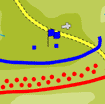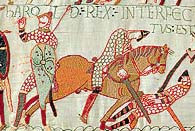![]() The
Battle of Hastings
The
Battle of Hastings
 On 6th October 1066 King Harold,
recently victorious against Harald Hardrada at Stamford Bridge in Yorkshire,
reached London. He then marched his weary army south again and on the 14th
October drew them up on a ridge, known to the Normans as Senlac Hill, blocking
William’s route out of Hastings.
On 6th October 1066 King Harold,
recently victorious against Harald Hardrada at Stamford Bridge in Yorkshire,
reached London. He then marched his weary army south again and on the 14th
October drew them up on a ridge, known to the Normans as Senlac Hill, blocking
William’s route out of Hastings.
Most of what we know about the Battle of Hastings comes from Norman sources and battle scenes are shown in the Bayeux Tapestry. There were probably 6 - 7000 men on each side. They wore helmets and chain mail armour and fought with swords and spears. The Normans also had archers and men on horseback while the English were largely foot soldiers.
 The English formed a shield wall
along the ridge with Harold and his brothers stationed at the highest point.
The Normans attacked up the ridge using their archers and spear throwers. One
source suggests that the Normans gained the upper hand by pretending to
retreat which led the English to pursue them into the low-lying ground below
the ridge where they were cut down by the Norman horsemen. Whether this
happened or not, in the end superior tactics wore down
the English. Although Harold and his men fought bravely, they were
comprehensively defeated. Harold was killed and his brothers and many English
lords also lost their lives.
The English formed a shield wall
along the ridge with Harold and his brothers stationed at the highest point.
The Normans attacked up the ridge using their archers and spear throwers. One
source suggests that the Normans gained the upper hand by pretending to
retreat which led the English to pursue them into the low-lying ground below
the ridge where they were cut down by the Norman horsemen. Whether this
happened or not, in the end superior tactics wore down
the English. Although Harold and his men fought bravely, they were
comprehensively defeated. Harold was killed and his brothers and many English
lords also lost their lives.
The Normans saw Harold’s defeat as the judgement of God on king who had broken his word to support William’s claim to the crown. In atonement for the great bloodshed at Hastings, however, William built an abbey at what became known as Battle, with the high altar on the place where Harold fell.